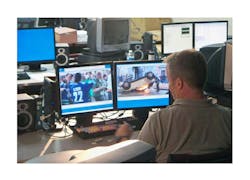Wanted: video analysis and artificial intelligence (AI) software to identify and locate people and vehicles
WASHINGTON – U.S. intelligence researchers are approaching industry to develop software algorithms to identify people and vehicles in video from many different cameras, locate these people and vehicles, and analyze the data for anomalies and threats.
Officials of the U.S. Intelligence Advanced Research Projects Agency (IARPA) in Washington issued a broad agency announcement on Tuesday for the Video Linking and Intelligence From Non-Collaborative Sensors (Video LINCS) program.
The program first will use artificial intelligence (AI) and machine learning to identify and locate people, later identify and locate vehicles, and finally identify and locate generic objects across video collections. IARPA is the research arm of the U.S. Office of The Director of National Intelligence.
In today’s world, video is a ubiquitous sensor, IARPA researchers explain. Although voluminous video data is collected, human analysts are too few and work too slowly to discern threats. Most human video analysis happens in reaction to tragic incidents.
Related: Artificial intelligence and machine learning for unmanned vehicles
In addition, different video sensors -- even within a facility -- rarely collaborate with each other. Ultimately, the burden on human analysts is high, and requires significant expertise, recall, and resources to pull threats out of mountains of video data.
The Video LINCS program consists of two technical areas: identifying people, vehicles, and generic objects across many video streams; and locating these object.
The Video LINCS objective is to reidentify objects across an arbitrary video collection without any prior access to the representative video or the objects to be identified.
The problem revolves around video that comes from many different sources with different characteristics that are difficult to associate.
Related: Enabling technologies for image and video processing
Video LINCS seeks to use video as an input, and generated identified object locations as an output. Geo-localization will provide tracks of objects, which requires mapping from camera coordinates to a common reference frame.
The Video LINCS program is planned as a four-year effort in three phases. The first 18-month phase will identify and locate people in video collections. An 18-month second phase will identify and locate people with clothing changes, as well as vehicles and generic objects. A yearlong third phase will emphasize generic objects. Those bidding must propose to all phases.
Those bidding should have expertise in artificial intelligence (AI); computer vision with object detection, tracking, and modeling; deep learning; geometric camera projections and inverse projections; image and video geo-localization; machine learning; modeling and simulation; open set classification; soft biometrics; software engineering; software integration; systems integration; ; vehicle fingerprinting; and video data generation.
Related: The role of technology in securing the nation’s borders
Companies interested should submit proposals no later than 15 July 2024 to the IARPA Distribution and Evaluation System (IDEAS) online at https://iarpa-ideas.gov/Client/signin.aspx.
Email questions or concerns to IARPA at [email protected]. More information is online at https://sam.gov/opp/e951e8e81d7442d6816e14b55dbbaf29/view, and at https://www.iarpa.gov/research-programs/video-lincs.
About the Author
John Keller
Editor-in-Chief
John Keller is the Editor-in-Chief, Military & Aerospace Electronics Magazine--provides extensive coverage and analysis of enabling electronics and optoelectronic technologies in military, space and commercial aviation applications. John has been a member of the Military & Aerospace Electronics staff since 1989 and chief editor since 1995.
